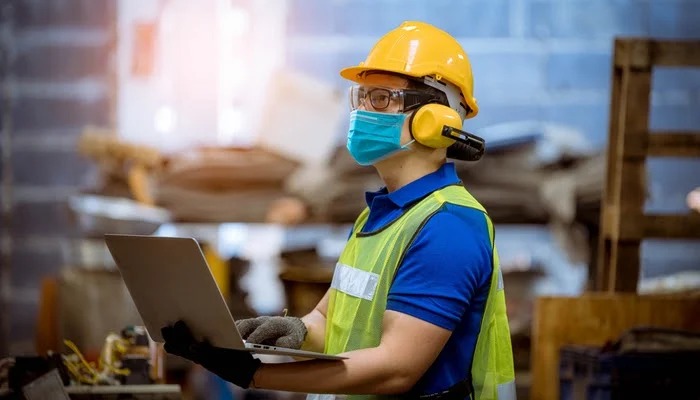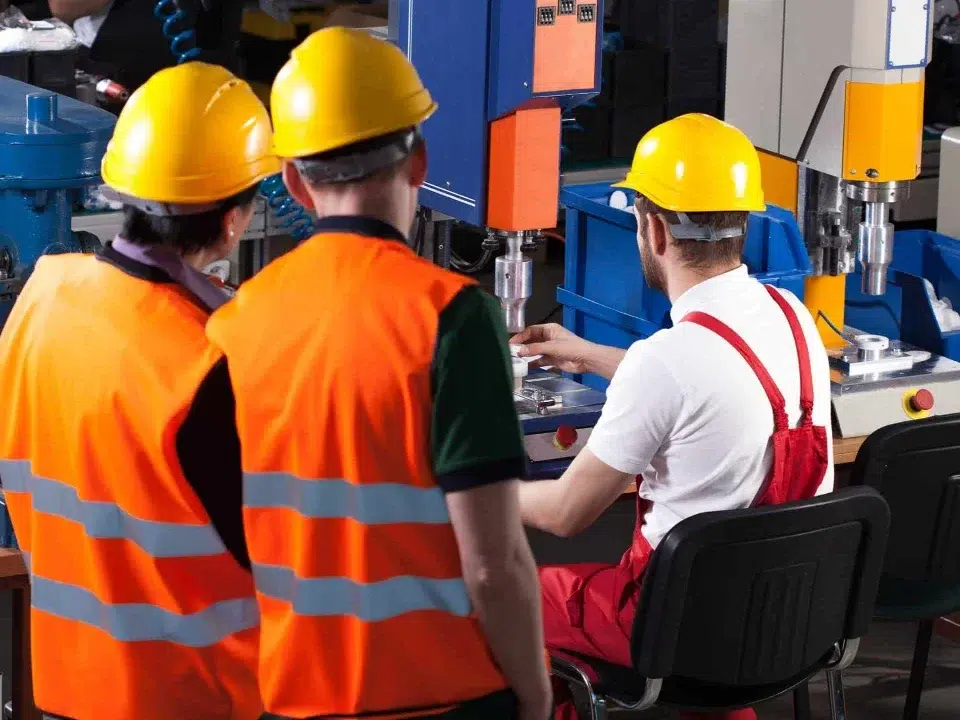Contractor Safety Management Implementation by TheSafetyMaster
Electrical Safety Audit, Thermography Assessment, and Arc Flash Assessment
September 18, 2023
Benefits of Implementing a Behavior-Based Safety Program
September 20, 2023Implementing effective contractor safety management is a crucial step towards ensuring a safe working environment for all individuals involved in a project. At TheSafetyMaster, we understand the significance of safeguarding the well-being of both our employees and contractors. Our commitment to prioritizing safety has driven us to develop a comprehensive framework for contractor safety management that encompasses various stages of evaluation, preparation, communication, and continuous monitoring.
With our systematic approach to contractor safety management, we aim to minimize risks and create an atmosphere where everyone feels secure and valued. By rigorously assessing our organization’s specific needs in relation to contractor safety, we lay the foundation for building a culture that prioritizes safety above all else. We firmly believe that proactive measures can prevent accidents from occurring in the first place.
Contractor safety management is a crucial aspect of any organization’s operations. TheSafetyMaster, a renowned leader in safety solutions, recognizes the importance of implementing effective strategies to ensure the well-being of contractors working on various projects. In this article, we will delve into the significance of contractor safety management and explore the comprehensive approach recommended by TheSafetyMaster for establishing a safe working environment.
Accidents and injuries can have devastating consequences, not only for the individuals involved but also for an organization’s reputation and bottom line. It is imperative to address contractor safety as a top priority to mitigate potential risks and create a culture of safety across all levels of an organization. Throughout this article, we will provide insights into each step of TheSafetyMaster’s contractor safety management implementation process, empowering organizations with practical strategies to safeguard their contractors.
Why Contractor Safety Management Matters
Ensuring the safety of contractors within your organization is not just a legal and ethical obligation, but also a crucial aspect of maintaining a thriving workplace. When it comes to contractor safety management, there are several key reasons why it matters.
First and foremost, prioritizing contractor safety demonstrates your commitment to creating a secure work environment for all individuals involved in your operations. This fosters a culture of care and responsibility, where employees and contractors alike feel valued and protected.
Moreover, effective contractor safety management minimizes the risk of accidents, injuries, and even fatalities. By implementing adequate safety measures and protocols, you reduce the likelihood of incidents that can result in financial loss, reputational damage, legal complications, and most importantly, harm to human lives.
In addition to these practical implications, investing in contractor safety management can have positive ripple effects throughout your organization. It boosts employee morale by instilling confidence that their well-being is paramount. Furthermore, it enhances productivity as workers can focus on their tasks without unnecessary concerns about hazardous working conditions.
In conclusion, contractor safety management is far more than just a bureaucratic exercise; it is an opportunity to create an environment where everyone feels safe and empowered. By valuing the well-being of contractors as much as your own employees’, you set a standard of excellence that not only protects lives but also cultivates success in all aspects of your organization.
The Dangers of Ignoring Contractor Safety
When it comes to workplace safety, neglecting the importance of contractor safety can have dire consequences. Failing to prioritize the safety of contractors not only puts their lives at risk but also jeopardizes the well-being of your entire organization. Ignoring contractor safety is akin to playing a dangerous game with high stakes – one that can result in severe injuries, legal liabilities, reputational damage, and financial losses.
Imagine a scenario where contractors working on your construction site are not provided with proper safety training or appropriate personal protective equipment. The lack of oversight and failure to enforce safety regulations could lead to accidents, injuries, or even fatalities. Not only would this be a tragic outcome for those directly affected, but it would also cast a dark shadow over your organization’s reputation and credibility. By ignoring contractor safety, you risk alienating employees, clients, and stakeholders who value ethical practices and a commitment to safeguarding human life.
The Journey Towards a Safe Working Environment
Creating a safe working environment is not an overnight task; it is a continuous journey filled with dedication, collaboration, and perseverance. The path towards achieving a safe working environment begins with acknowledging the importance of contractor safety management and understanding the potential risks that can arise if it is neglected.
As an organization, you must commit to building a culture of safety that permeates every level and department. This involves fostering open lines of communication, encouraging employee involvement in safety initiatives, and providing the necessary resources for training and implementation. By creating this culture of safety, you empower your workforce to take ownership of their own safety and that of their fellow workers.
Step 1: Assessing Your Organization’s Needs
Before embarking on the journey towards contractor safety management, it is crucial to assess your organization’s specific needs. This step sets the foundation for a successful implementation, ensuring that the strategies implemented are tailored to address your unique challenges and requirements.
Start by conducting a comprehensive review of your organization’s current safety practices, policies, and procedures. Identify any gaps or areas of improvement where contractors’ safety might be at risk. Consider factors such as the nature of work being performed, potential hazards involved, and the level of expertise required from contractors.
Additionally, engaging with key stakeholders within your organization is vital. Seek input from various departments and personnel who interact directly or indirectly with contractors. Their perspectives will provide valuable insights into specific safety concerns and potential areas for enhancement.
This assessment phase not only illuminates the existing safety landscape but also serves as an opportunity to foster a sense of collective responsibility towards contractor safety within your organization. By involving stakeholders early on, you create an inclusive environment where everyone feels invested in creating a safe working environment for all individuals involved.
Step 2: Building a Culture of Safety
Building a culture of safety is paramount in creating a work environment where every individual prioritizes their well-being and that of others. It goes beyond simply implementing policies and procedures; it involves instilling the belief that safety is an integral part of every task, decision, and interaction.
In order to build this culture, start by fostering open communication channels that encourage employees and contractors to voice their concerns without fear or hesitation. This can be achieved through regular safety meetings, toolbox talks, and anonymous reporting systems. By actively listening and addressing these concerns promptly, you demonstrate your commitment to creating a safe space for everyone.
Additionally, providing comprehensive training programs not only ensures that individuals understand safety protocols but also empowers them to take ownership of their actions. Encourage employees and contractors to share their experiences and lessons learned from past incidents or near misses, promoting a collective learning environment. Celebrate successes in meeting safety goals, reinforcing the notion that everyone’s effort contributes to the overall well-being of the organization.
Step 3: Establishing Clear Safety Policies and Procedures
Establishing clear safety policies and procedures is the cornerstone of a robust contractor safety management system. These policies provide a framework for ensuring consistent adherence to safety standards and guidelines, minimizing the risk of accidents, injuries, and even fatalities.
When crafting safety policies, it is crucial to consider every aspect of your organization’s operations. Begin by conducting thorough risk assessments to identify potential hazards in different work areas. This will enable you to develop specific safety protocols tailored to each task or job site, ensuring that contractors are aware of the risks involved and know how to mitigate them effectively.
Step 4: Selecting Contractors Carefully
The process of selecting contractors for your organization should not be taken lightly, as their actions on your premises can have far-reaching consequences. The first step is to conduct a thorough evaluation of potential contractors, considering their experience, qualifications, and safety track record. Look for contractors who prioritize safety and have a proven commitment to following industry best practices. This includes reviewing their safety policies and procedures, conducting site visits to assess their work conditions, and checking references to gauge their reputation.
Furthermore, it is essential to establish clear criteria for contractor selection. Consider factors such as training programs implemented by the contractor’s company, certifications obtained by their workforce in relevant safety regulations, and whether they possess specialized knowledge in handling specific hazardous materials or equipment. By carefully vetting contractors based on these criteria, you can ensure that you are partnering with professionals who share your commitment to maintaining a safe working environment.
Step 5: Preparing for Contractor Onboarding
When it comes to ensuring contractor safety, proper onboarding is crucial. This step involves meticulous planning and careful execution to guarantee that contractors fully comprehend and adhere to your organization’s safety protocols. By establishing a comprehensive onboarding process, you create a foundation for a harmonious working relationship that prioritizes safety above all else.
The first aspect of preparing for contractor onboarding is developing an orientation program specifically tailored to the unique needs of contractors. This program should encompass detailed information about your organization’s safety policies, emergency procedures, hazard identification techniques, and the proper use of personal protective equipment. By providing contractors with this knowledge upfront, you empower them to make informed decisions and perform their work safely from day one.
Step 6: Effective Communication and Training
To ensure a safe working environment, effective communication and comprehensive training are paramount. By fostering open lines of communication, both internally and with contractors, potential hazards and safety concerns can be identified and addressed promptly. Regular safety meetings should be conducted to discuss any new procedures or guidelines, allowing for the exchange of ideas and feedback.
The training programs should be tailored to meet the specific needs of both employees and contractors. Utilizing a variety of training methods such as videos, workshops, and interactive sessions can help engage participants actively in their learning process. Emphasize the importance of adhering to safety standards at all times by highlighting real-life examples that demonstrate the positive impact of following proper safety protocols.
A positive approach to training not only promotes compliance but also instills a sense of responsibility among individuals involved. Encourage participation in ongoing professional development opportunities related to safety management. By investing in continuous learning initiatives, organizations not only enhance their workforce’s skills but also reaffirm their commitment towards creating a safe work environment.
Step 7: Continuous Monitoring and Evaluation
Once your contractor safety management system is implemented, it is imperative to establish a framework for continuous monitoring and evaluation. This step ensures that safety measures remain effective and any potential gaps or shortcomings are identified and rectified promptly.
The process of continuous monitoring involves regular inspections, audits, and assessments to gauge the compliance of both contractors and your organization with established safety protocols. It is essential to conduct periodic site visits to observe work activities firsthand, checking if safety measures are being followed diligently. Additionally, reviewing incident reports, near-miss incidents, and conducting safety meetings will provide valuable insights into potential areas for improvement.
Evaluation is equally vital in this step as it allows you to measure the effectiveness of your contractor safety management system over time. Analyzing data collected from inspections, incident reports, training programs, and performance metrics will help identify trends or patterns that require attention. By examining these findings comprehensively, you can make informed decisions about implementing additional safety measures or revising existing policies.
Continuous monitoring and evaluation go beyond mere compliance; they foster a culture of proactive risk assessment. This approach not only safeguards workers but also creates an optimistic atmosphere where individuals feel empowered to contribute actively towards reinforcing a safe working environment. Remember, constant vigilance ensures that contractor safety remains a top priority while striving for excellence in all aspects of operations.
Conclusion
In conclusion, the implementation of a comprehensive contractor safety management program is paramount to ensuring a safe and secure working environment for all stakeholders involved. By taking the necessary steps outlined in this article, organizations can significantly reduce the risks associated with contractor-related accidents and incidents.
Remember, safety should never be seen as an afterthought but rather as an integral part of every business operation. The proactive approach to contractor safety not only protects lives but also enhances productivity, boosts employee morale, and improves overall organizational performance.
As we move forward in our commitment to creating a culture of safety, let us embrace the notion that protecting human lives is not just a legal requirement but a moral obligation. By prioritizing contractor safety management, we are investing in our future, where accidents become rare occurrences and each worker returns home unharmed at the end of every day.




